Advancements and Prospects in Electro-Sinter-Forging
Abstract
:1. Introduction
2. Characteristics of the Process
3. Materials
4. Metals
4.1. Iron-Based
4.2. 100Cr6-Like Composition
4.3. Tool Steels
4.4. Stainless Steels
4.5. Copper-Based
4.6. Aluminium-Based
5. Other Metals
6. Intermetallic Materials
6.1. TiAl
6.2. Nd2Fe14B
6.3. Bi2Te3
7. Discussion and Critical Assessment
8. Future Prospects and Open Issues
- How do the mechanical properties compare to traditional cast and machined parts?
- What maximum and minimum sizes of parts will be processable with the future machines?
- What level of complexity of the components will be available? Is multi-axis/multi-level electro-sinter-forging possible?
- Can extremely high values of vacuum improve the mechanical properties?
- Are there ways to rapidly de-oxidise powders before electro-sinter-forging or should special powders be produced and properly stocked?
- Is it possible to induce reactions with interstitial gases to create novel ceramic or composite materials?
Funding
Data Availability Statement
Acknowledgments
Conflicts of Interest
References
- Anselmi-Tamburini, U.; Groza, J.R. Critical assessment: Electrical field/current application–A revolution in materials processing/sintering? Mater. Sci. Technol. 2017, 33, 1855–1862. [Google Scholar] [CrossRef] [Green Version]
- Orrù, R.; Licheri, R.; Locci, A.M.; Cincotti, A.; Cao, G. Consolidation/synthesis of materials by electric current activated/assisted sintering. Mater. Sci. Eng. R Rep. 2009, 63, 127–287. [Google Scholar] [CrossRef]
- Angerer, P.; Neubauer, E.; Yu, L.G.; Khor, K.A. Texture and structure evolution of tantalum powder samples during spark-plasma-sintering (SPS) and conventional hot-pressing. Int. J. Refract. Met. Hard Mater. 2007, 25, 280–285. [Google Scholar] [CrossRef]
- Bokhonov, B.B.; Ukhina, A.V.; Dudina, D.V.; Anisimov, A.G.; Mali, V.I.; Batraev, I.S. Carbon uptake during Spark Plasma Sintering: Investigation through the analysis of the carbide ‘footprint’ in a Ni-W alloy. RSC Adv. 2015, 5, 80228–80237. [Google Scholar] [CrossRef]
- Neamţu, B.V.; Chicinaş, I.; Isnard, O.; Ciascai, I.; Chiriac, H.; Lostun, M. Magnetic properties of nanocrystalline Ni3Fe compacts prepared by spark plasma sintering. Intermetallics 2013, 35, 98–103. [Google Scholar] [CrossRef]
- Yurlova, M.S.; Demenyuk, V.D.; Lebedeva, L.Y.; Dudina, D.V.; Grigoryev, E.G.; Olevsky, E.A. Electric pulse consolidation: An alternative to spark plasma sintering. J. Mater. Sci. 2014, 49, 952–985. [Google Scholar] [CrossRef]
- Aranda, R.M.; Ternero, F.; Lozano-Pérez, S.; Montes, J.M.; Cuevas, F.G. Capacitor electrical discharge consolidation of metallic powders—A review. Metals 2021, 11, 616. [Google Scholar] [CrossRef]
- Raghunathan, S.K.; Persad, C.; Bourell, D.L.; Marcus, H.L. High-energy, high-rate consolidation of tungsten and tungsten-based composite powders. Mater. Sci. Eng. A 1991, 131, 243–253. [Google Scholar] [CrossRef]
- Kim, Y.W.; Bourell, D.L.; Persad, C. High energy, high rate powder processing of a rapidly quenched quaternary alloy, Ni56.5Mo23.5Fe10B10. Mater. Sci. Eng. A 1990, 123, 99–115. [Google Scholar] [CrossRef]
- Ervin, D.R.; Bourell, D.L.; Persad, C.; Rabenberg, L. Structure and properties of high energy, high rate consolidated molybdenum alloy TZM. Mater. Sci. Eng. A 1988, 102, 25–30. [Google Scholar] [CrossRef]
- Chen, W.; Anselmitamburini, U.; Garay, J.E.; Groza, J.; Munir, Z. Fundamental investigations on the spark plasma sintering/synthesis processI. Effect of dc pulsing on reactivity. Mater. Sci. Eng. A 2005, 394, 132–138. [Google Scholar] [CrossRef]
- Fais, A. Processing characteristics and parameters in capacitor discharge sintering. J. Mater. Process. Technol. 2010, 210, 2223–2230. [Google Scholar] [CrossRef]
- Okazaki, K. Electro-discharge consolidation applied to nanocrystalline and RSP/MA powders. Mater. Sci. Eng. A 2000, 287, 189–197. [Google Scholar] [CrossRef]
- Grigoriev, E.G.; Rosliakov, A.V. Electro-discharge compaction of WC-Co and W-Ni-Fe-Co composite materials. J. Mater. Process. Technol. 2007, 191, 182–184. [Google Scholar] [CrossRef]
- Alp, T.; Can, M.; Al-Hassani, S.T.S. Electroimpact compaction of PM components. Powder Metall. 1987, 30, 29–36. [Google Scholar] [CrossRef]
- Rajagopalan, P.K.; Desai, S.V.; Kalghatgi, R.S.; Krishnan, T.S.; Bose, D.K. Studies on the electric discharge compaction of metal powders. Mater. Sci. Eng. A 2000, 280, 289–293. [Google Scholar] [CrossRef]
- An, Y.B.; Oh, N.H.; Chun, Y.W.; Kim, Y.H.; Kim, D.K.; Park, J.S.; Kwon, J.-J.; Choi, K.O.; Eom, T.G.; Byun, T.H.; et al. Mechanical properties of environmental-electro-discharge-sintered porous Ti implants. Mater. Lett. 2005, 59, 2178–2182. [Google Scholar] [CrossRef]
- Schütte, P.; Garcia, J.; Theisen, W. Electro discharge sintering as a process for rapid compaction in PM-technology. In European Congress and Exhibition on Powder Metallurgy. European PM Conference Proceedings (p. 1); EPMA: Chantilly, France, 2009. [Google Scholar]
- Fais, A.; Scardi, P. Capacitor discharge sintering of nanocrystalline copper. Zeitschrift Krist. Suppl. 2008, 27, 37–44. [Google Scholar] [CrossRef]
- Fais, A. Sintering Process and Corresponding Sintering System. U.S. Patent No. 9,227,244, 5 January 2016. [Google Scholar]
- Fais, A. A faster FAST: Electro-Sinter-Forging. Met. Powder Rep. 2018, 73, 80–86. [Google Scholar] [CrossRef]
- Fais, A.; Maizza, G. Densification of AISI M2 high speed steel by means of capacitor discharge sintering (CDS). J. Mater. Process. Technol. 2008, 202, 70–75. [Google Scholar] [CrossRef]
- Valentin, C.; Cannella, E.; Nielsen, C.V. Tool Design and Materials for Electro Sinter Forging (ESF) Tool Design and Materials for Electro Sinter Forging (ESF). 2018. Available online: https://www.researchgate.net/publication/323701086 (accessed on 18 April 2022).
- Cannella, E.; Nielsen, C.V.; Bay, N. Electro Sinter Forging of Titanium Disks. In Euspen Special Interest Group Meeting: Micro/Nano Manufacturing; 2017; pp. 4–6. Available online: https://www.researchgate.net/publication/322397356_Electro_sinter_forging_of_titanium_disks (accessed on 18 April 2022).
- Cannella, E.; Nielsen, C.V.; Bay, N. On the process and product fingerprints for electro sinter forging (ESF). Micromachines 2019, 10, 218. [Google Scholar] [CrossRef] [PubMed] [Green Version]
- Semenov, A.S.; Trapp, J.; Nothe, M.; Eberhardt, O.; Wallmersperger, T.; Kieback, B. Thermo-electro-mechanical modeling, simulation and experiments of field-assisted sintering. J. Mater. Sci. 2019, 54, 10764–10783. [Google Scholar] [CrossRef]
- Sheng, Y.; Hua, Y.; Wang, X.; Zhao, X.; Chen, L.; Zhou, H.; Wang, J.; Berndt, C.C.; Li, W. Application of high-density electropulsing to improve the performance of metallic materials: Mechanisms, microstructure and properties. Materials 2018, 11, 185. [Google Scholar] [CrossRef] [PubMed] [Green Version]
- Okazaki, K.; Kagawa, M.; Conrad, H. Effects of strain rate, temperature and interstitial content on the electroplastic effect in titanium. Scr. Metall. 1979, 13, 473–477. [Google Scholar] [CrossRef]
- Conrad, H. A study into the mechanism(s) for the electroplastic effect in metals and its application to metalworking, processing and fatigue. U.S. Army Res. Off. 1989. Available online: https://apps.dtic.mil/sti/citations/ADA209218 (accessed on 18 April 2022).
- Okazaki, K.; Kagawa, M.; Conrad, H. An evaluation of the contributions of skin, pinch and heating effects to the electroplastic effect in titatnium. Mater. Sci. Eng. 1980, 45, 109–116. [Google Scholar] [CrossRef]
- Yang, D.; Conrad, H. Exploratory study into the effects of an electric field and of high current density electropulsing on the plastic deformation of TiAl. 2001, 9, 943–947. Intermetallics 2001, 9, 943–947. [Google Scholar] [CrossRef]
- Fais, A.; Grande, M.A.; Forno, I. Influence of processing parameters on the mechanical properties of Electro-Sinter-Forged iron based powders Alessandro. Mater. Des. 2016, 93, 458–466. [Google Scholar] [CrossRef]
- Gobber, F.S.; Bidulská, J.; Fais, A.; Franchini, F.; Bidulský, R.; Kvačkaj, T.; Actis Grande, M. Characterization of microstructural and mechanical properties after cold rolling of an electro-sinter-forged Cu-Sn alloy. Arch. Metall. Mater. 2020, 65, 787–792. [Google Scholar]
- Fais, A. E-ForgingTM AlSi10 and AlSi10Mg0.4 powders with two distinct particle sizes. In European Powder Metallurgy Congress and Exhibition, Euro PM 2019; EPMA: Chantilly, France, 2019. [Google Scholar]
- Balagna, C.; Fais, A.; Brunelli, K.; Peruzzo, L.; Horynová, M.; Čelko, L.; Spriano, S. Electro-sinter-forged Ni-Ti alloy. Intermetallics 2016, 68, 31–41. [Google Scholar] [CrossRef]
- Gobber, F.S.; Bidulská, J.; Fais, A.; Bidulský, R.; Grande, M.A. Innovative densification process of a fe-cr-c powder metallurgy steel. Metals 2021, 11, 665. [Google Scholar] [CrossRef]
- Beiss, P.; Kientopf, G. Hot Isostatically Pressed Tool Steels: Microstructure: Datasheet from Landolt-Börnstein-Group VIII Advanced Materials and Technologies Volume 2A1: ‘Powder Metallurgy Data’ in SpringerMaterials; Springer: Berlin/Heidelberg, Germany, 2003. [Google Scholar] [CrossRef]
- Gobber, F.S.; Fracchia, E.; Fais, A.; Peter, I.; Grande, M.A. Characterization of AlSi10Mg-CP-Ti metal/metal composite materials produced by electro-sinter-forging. Metals 2021, 11, 1645. [Google Scholar] [CrossRef]
- Gobber, F.S.; Fracchia, E.; Spotorno, R.; Fais, A.; Manfredi, D. Wear and corrosion resistance of alsi10mg–cp–ti metal–metal composite materials produced by electro-sinter-forging. Materials 2021, 14, 6761. [Google Scholar] [CrossRef]
- Balagna, C.; Fais, A.; Brunelli, K.; Peruzzo, L.; Spriano, S. Effect of heat treatments on a Ni-Ti alloy sintered by Electro-Sinter-Forging. J. Alloys Compd. 2017, 726, 338–347. [Google Scholar] [CrossRef]
- Forno, I.; Grande, M.A.; Fais, A. On the application of Electro-sinter-forging to the sintering of high-karatage gold powders. Gold Bull. 2015, 48, 3–4. [Google Scholar] [CrossRef] [Green Version]
- Fais, A. Electro-Sinter-Forging for the production of diamond segments. Diamante 2015, 18, 21AD. [Google Scholar]
- Fais, A. Composite Magnetic Materials and Method of Manufacturing the Same. 2021. Available online: https://data.epo.org/publication-server/document?iDocId=6609302&iFormat=0 (accessed on 18 April 2022).
- Khlopkov, K.; Gutfleisch, O.; Schäfer, R.; Hinz, D.; Müller, K.H.; Schultz, L. Interaction domains in die-upset NdFeB magnets in dependence on the degree of deformation. J. Magn. Magn. Mater. 2004, 272–276 (Suppl. S1), 2003–2005. [Google Scholar] [CrossRef]
- Grünberger, W.; Hinz, D.; Kirchner, A.; Müller, K.H.; Schultz, L. Hot deformation of nanocrystalline Nd-Fe-B alloys. IEEE Trans. Magn. 1997, 33, 3889–3891. [Google Scholar] [CrossRef]
- Goldsmid, H.J. Bismuth telluride and its alloys as materials for thermoelectric generation. Materials 2014, 7, 2577–2592. [Google Scholar] [CrossRef] [Green Version]
- Goldsmid, H.J. The Improvement of a Specific Material–Bismuth Telluride. In Introduction to Thermoelectricity; Springer: Berlin/Heidelberg, Germany, 2010; pp. 85–107. [Google Scholar]
- Fais, A. Discharge sintering of hard metal cutting tools. In Proceedings of the International Powder Metallurgy Congress and Exhibition, Euro PM (pp. 13–18); EPMA: Chantilly, France, 2013. [Google Scholar]
- Hundertmark, S.; Liebfried, O. Power Supply Options for a Naval Railgun. IEEE Trans. Plasma Sci. 2018, 46, 3599–3605. [Google Scholar] [CrossRef]
- Sinars, D.B.; Sweeney, M.A.; Alexander, C.S.; Ampleford, D.J.; Ao, T.; Apruzese, J.P.; Aragon, C.; Armstrong, D.J.; Austin, K.N.; Awe, T.J.; et al. Review of pulsed power-driven high energy density physics research on Z at Sandia. Phys. Plasmas 2020, 27, 7. [Google Scholar] [CrossRef]
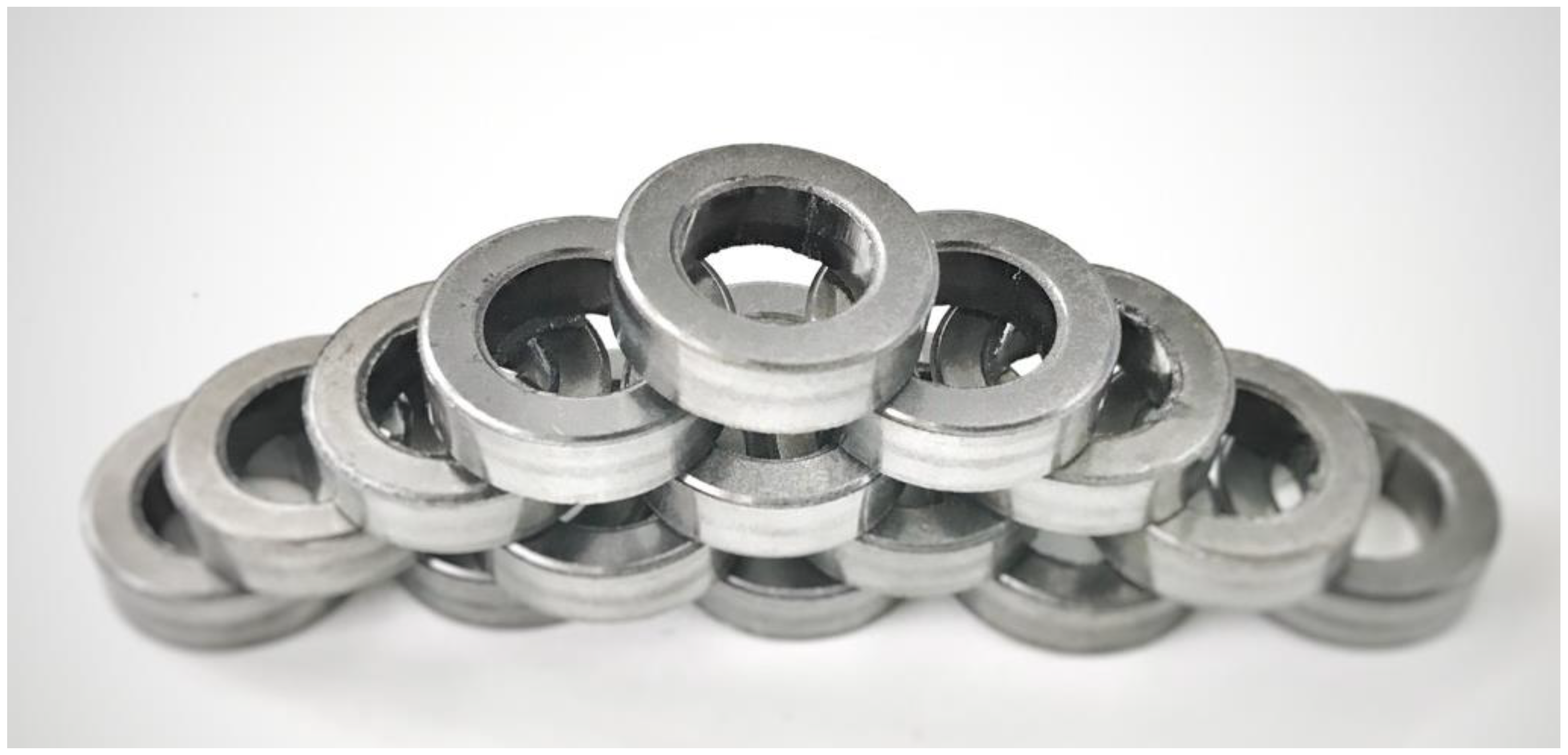
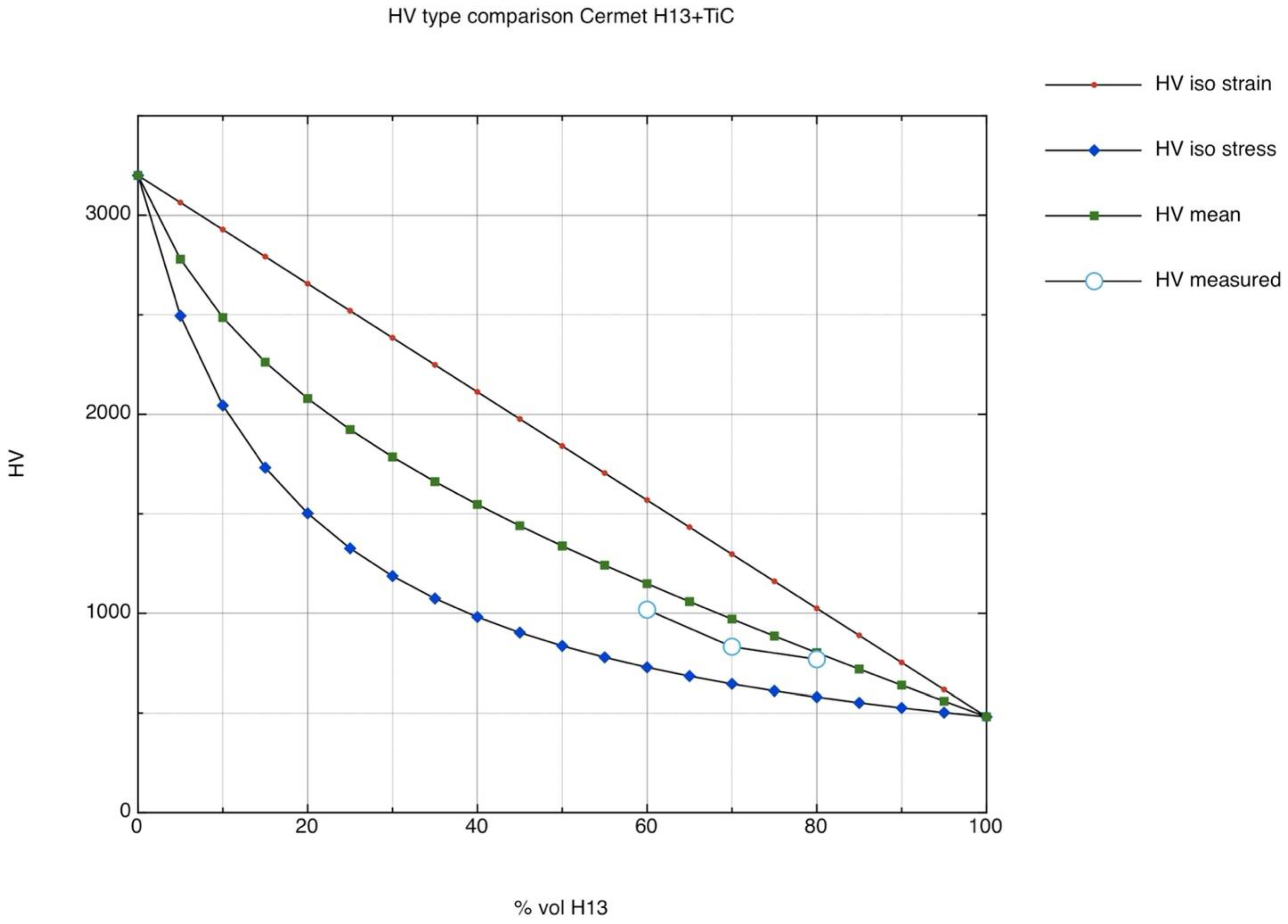
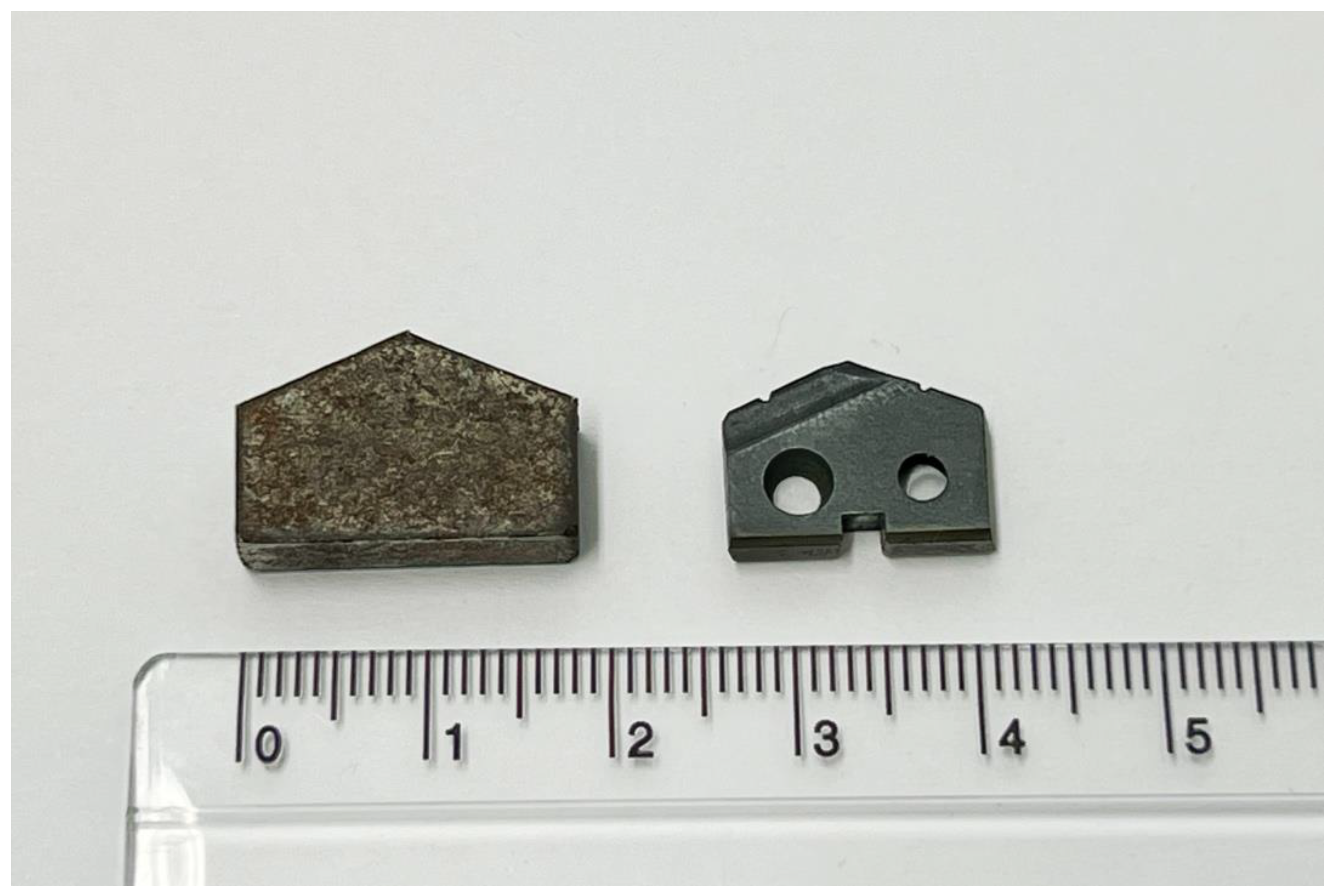
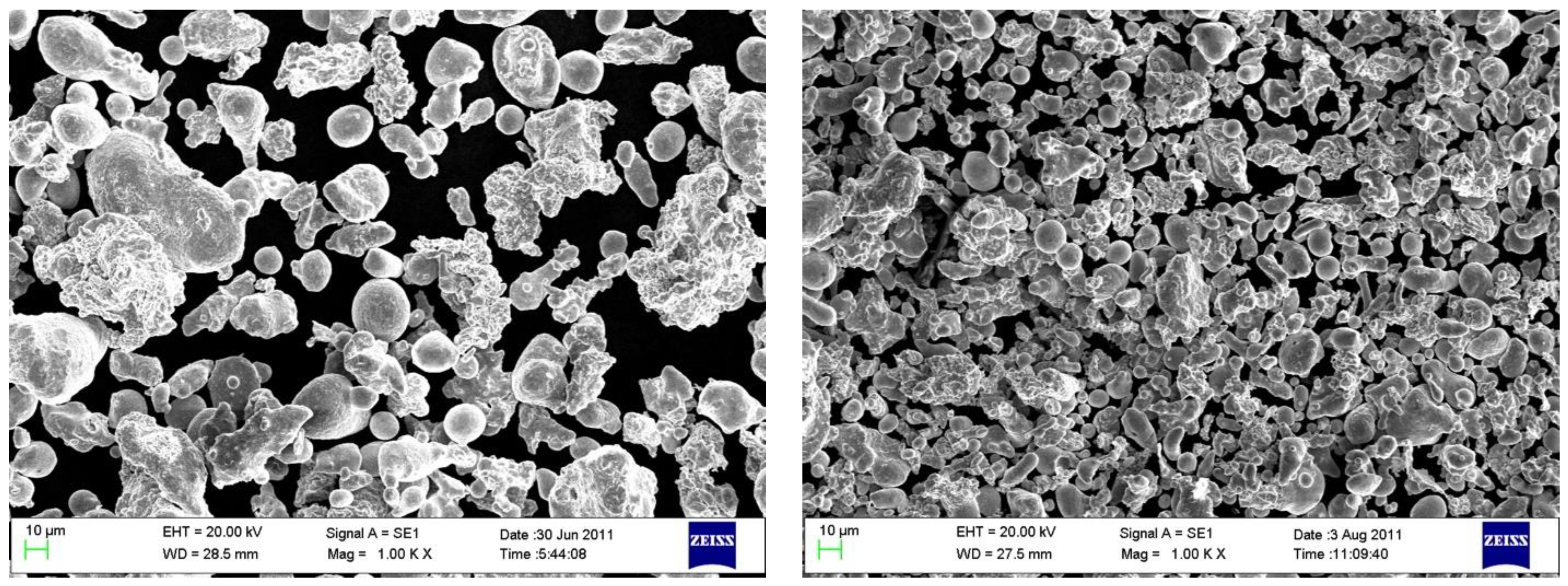

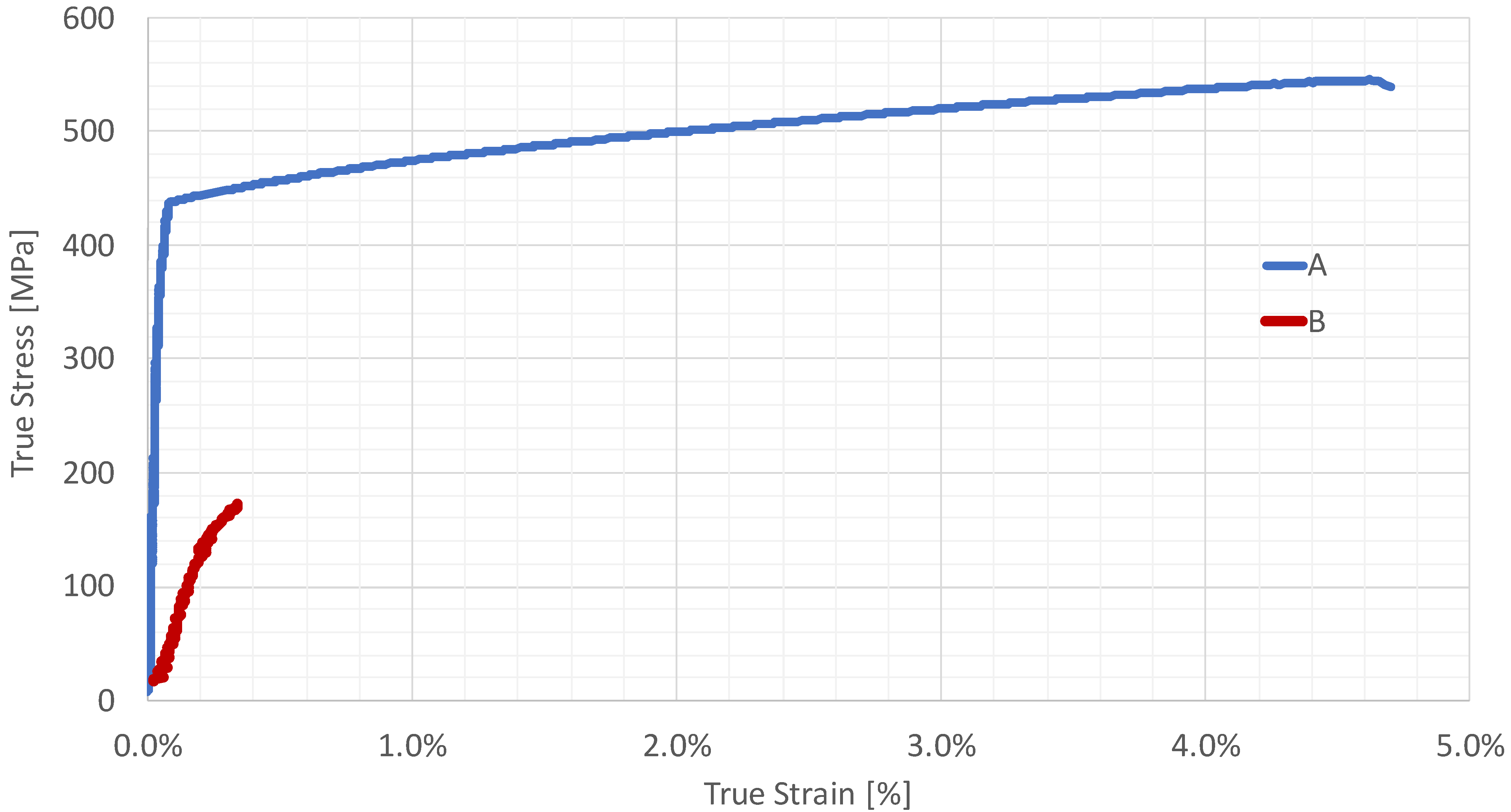
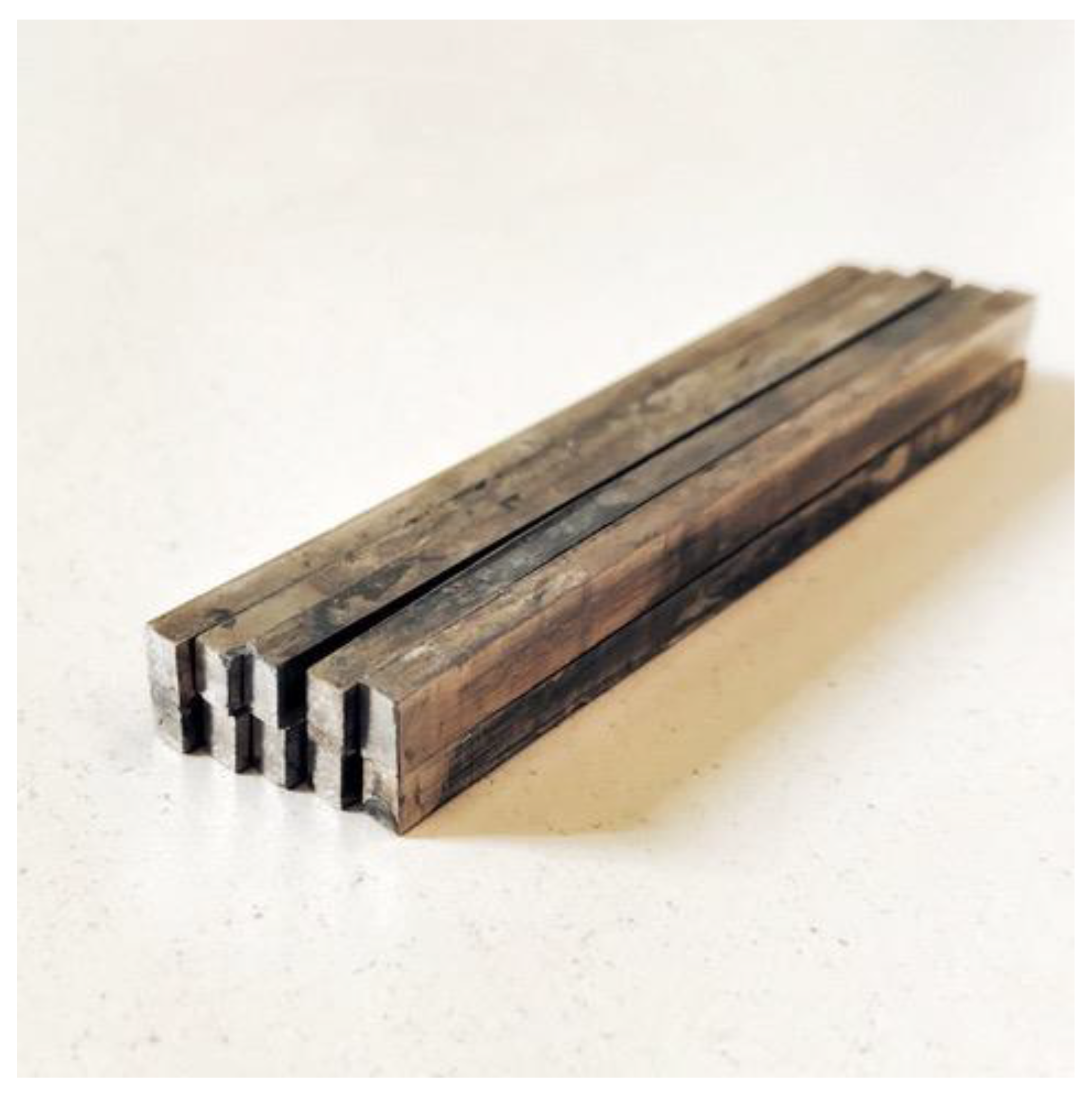
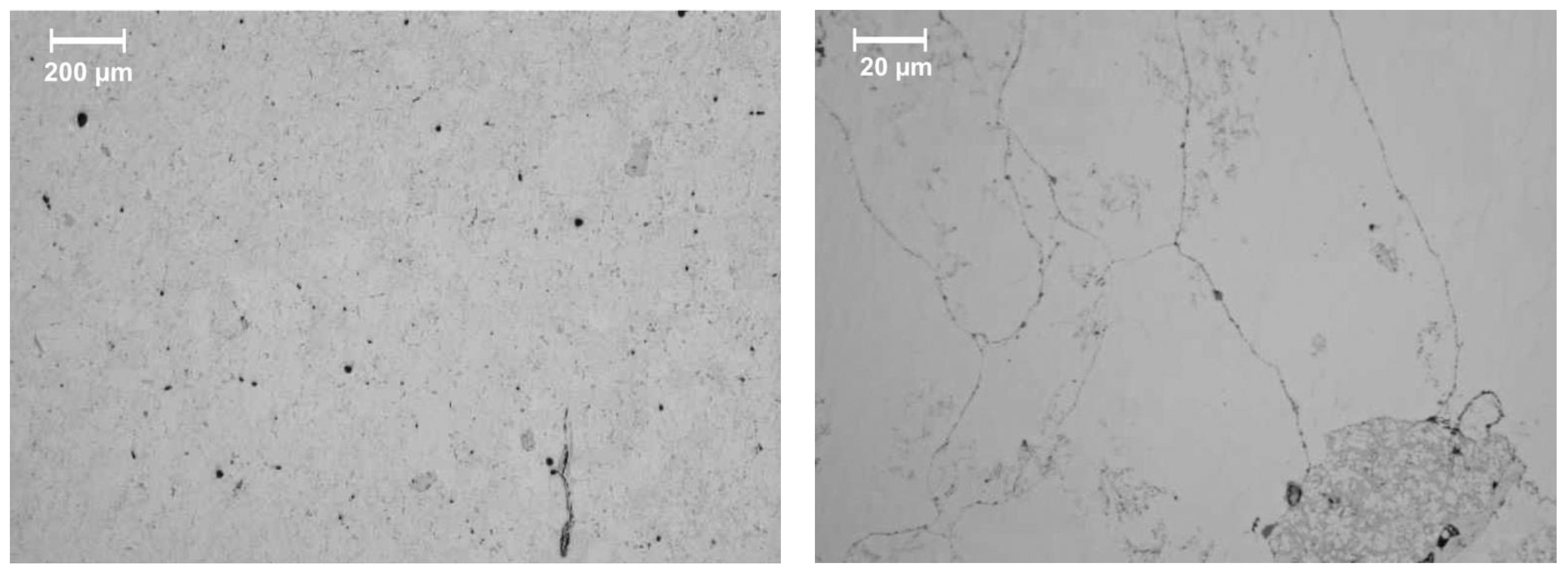


| Material | Size/Dimensions (mm) | Density (%) | Starting Powder | Initial Pressure (MPa) | Maximum Pressure (MPa) | SEI (kJ/g) | References |
|---|---|---|---|---|---|---|---|
| Iron alloy | 20 × 10 × 4 | 99% | Pre-alloyed Astaloy CrL | 50 | 115 | 2.2 | [32] |
| 0.2% carbon steel | ∅10 × 4 | 100% | Iron + graphite flakes | 80 | 300 | 2.2 | Present work |
| AISI H13 | 20 × 10 × 4 | 100% | Pre-alloyed | 60 | 270 | 2.2 | Present work |
| AISI 316L | ∅10 × 3 | 100% | Pre-alloyed | 150 | 200 | 3.5 | Present work |
| 17-4PH | ∅10 × 3 | 100% | Pre-alloyed | 200 | 240 | 2.1 | Present work |
| 100Cr6 cam follower | ED 15.4 ID 9.3 h 4.5 | 100% | Astaloy CrM + Graphite | 20 | 200 | 3 | Present work |
| H13 + 20% vol TiC | A = 188.55 mm2 h = 4.6 mm, CS0 | 100% | Pre-alloyed + TiC, simply mixed | 30 | 400 | 1.12 | Present work |
| H13 + 30% vol TiC | A = 188.55 mm2 h = 4.6 mm, CS0 | 98% | Pre-alloyed + TiC, simply mixed | 160 | 230 | 1.35 | Present work |
| H13 + 40% vol TiC | A = 188.55 mm2 h = 4.6 mm, CS0 | 98% | Pre-alloyed + TiC, simply mixed | 160 | 300 | 1.5 | Present work |
| 85-15 Cu-Sn irregular | ∅10 × 6 | 100% | Pre-mix of master alloy + Cu | 80 | 120 | 0.75 | Present work |
| 85-15 Cu-Sn irregular | 20 × 10 × 4 | 100% | Pre-mix of master alloy + Cu | 20 | 140 | 1.16 | Present work |
| 85-15 Cu-Sn irregular | 80 × 5 × 3 | 100% | Pre-mix of master alloy + Cu | 50 | 215 | 1 | Present work, used in [33] |
| 85-15 Cu-Sn “bronzo finissimo” | 20 × 10 × 4 | 100% | Pre-alloyed | 20 | 100 | 1.28 | Present work |
| AlSi10 < 63 µm | ∅10 × 4 | 100% | Pre-alloyed | 77 | 260 | 4.7 | [34] |
| AlSi10Mg0.4 < 63 µm | ∅10 × 4 | 100% | Pre-alloyed | 40 | 240 | 4.4 | [34] |
| Al 6061 | 20 × 10 × 4 | 99% | Pre-mix of master alloy + Al | 20 | 240 | 1.7 | Present work |
| Al 7075 | 20 × 10 × 4 | 100% | Pre-mix of master alloy + Al | 20 | 210 | 2.9 | Present work |
| Incoloy 625 | ∅10 × 4 | 100% | Pre-alloyed | 200 | 230 | 2.4 | Present work |
| NiTiNOL | ∅10 × 4 | 100% | Pre-alloyed | 155 | 350 | 2.6 | [35] |
| Bi2-Te3 | ∅10 × 10 | 100% | Pre-alloyed | 100 | 244 | 0.22 | Present work |
| TiAl | ∅10 × 4 | 100% | Pre-alloyed (swarf) | 120 | 320 | 3 | Present work |
| MQU NdFeB | ∅10 × 3.3 | 99.5% | Flakes, Pre-alloyed | 100 | 250 | 2.7 | Present work |
Publisher’s Note: MDPI stays neutral with regard to jurisdictional claims in published maps and institutional affiliations. |
© 2022 by the author. Licensee MDPI, Basel, Switzerland. This article is an open access article distributed under the terms and conditions of the Creative Commons Attribution (CC BY) license (https://creativecommons.org/licenses/by/4.0/).
Share and Cite
Fais, A. Advancements and Prospects in Electro-Sinter-Forging. Metals 2022, 12, 748. https://doi.org/10.3390/met12050748
Fais A. Advancements and Prospects in Electro-Sinter-Forging. Metals. 2022; 12(5):748. https://doi.org/10.3390/met12050748
Chicago/Turabian StyleFais, Alessandro. 2022. "Advancements and Prospects in Electro-Sinter-Forging" Metals 12, no. 5: 748. https://doi.org/10.3390/met12050748






